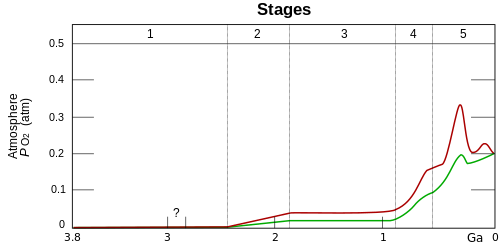
Back Groot Suurstofkatastrofe Afrikaans حدث الأكسدة الكبير Arabic Oksigen fəlakəti Azerbaijani Кислород һәләкәте Bashkir বৃহৎ জারণ ঘটনা Bengali/Bangla Catàstrofe de l'oxigen Catalan Velká kyslíková katastrofa Czech Iltkatastrofen Danish Große Sauerstoffkatastrophe German Great Oxidation Event English
The Great Oxygenation Event (GOE)[1] was the creation of free oxygen in our atmosphere. It was caused by cyanobacteria doing photosynthesis. It took a very long time, from three billion years ago to about one billion years ago.[2]
Photosynthesis was making oxygen both before and after the GOE. Before the GOE, organic matter and dissolved iron chemically captured any free oxygen. Earth has much iron, and iron has higher solubility than its oxides, so the oceans had much dissolved iron. It became iron oxide and made huge deposits of banded iron rock from the Archaean and Proterozoic eras. When not enough iron remained to capture more oxygen, free oxygen accumulated in the atmosphere. This was the GOE.[3]

Stage 1 (3.85–2.45 Ga): Practically no O2 in the atmosphere.
Stage 2 (2.45–1.85 Ga): O2 produced, but absorbed in oceans & seabed rock.
Stage 3 (1.85–0.85 Ga): O2 starts to gas out of the oceans, but is absorbed by land surfaces.
Stages 4 & 5 (0.85–present): O2 sinks filled and the gas accumulates.[4]
Oxygen was toxic to most of the Earth's anaerobic inhabitants at the time. As cyanobacteria produced oxygen, and built their stromatolites, they changed the environment for other protists. Since the other protists had no way to deal with oxygen, most became extinct. Another consequence was the effect of free oxygen on atmospheric methane, a greenhouse gas. Their reaction removed the methane, and caused the Huronian glaciation. This was perhaps the longest snowball Earth episode ever. Free oxygen has been an important part of the atmosphere ever since.[5][6]
- ↑ also called the Oxygen Catastrophe, Oxygen Crisis, or Oxygen Revolution.
- ↑ Zimmer, Carl (3 October 2013). Earth's oxygen: a mystery easy to take for granted. New York Times. Retrieved 3 October 2013.
- ↑ Canfield, Donald 2014. Oxygen: a four billion year history. Princeton: Princeton University Press. ISBN 978-0-691-14502-0
- ↑ Holland, Heinrich D. 2006.The oxygenation of the atmosphere and oceans. Philosophical Transactions of the Royal Society: Biological Sciences. 361, 903–915.
- ↑ Frei R. et al 2009. Fluctuations in Precambrian atmospheric oxygenation recorded by chromium isotopes. Nature 461 (7261): 250–253.
- ↑ Lyons, Timothy W. & Reinhard, Christopher T. 2009. Early Earth: Oxygen for heavy-metal fans. Nature 461, 179–181.